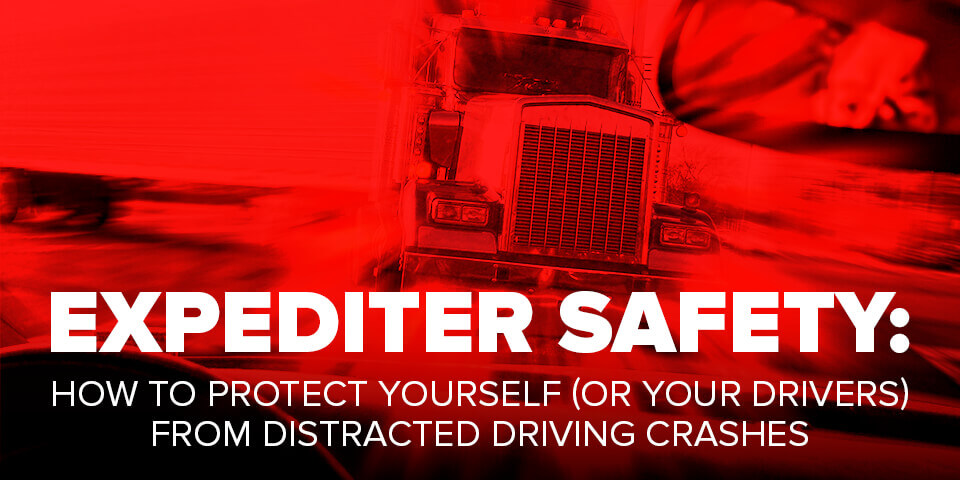In The News

Expediter Safety: How to Protect Yourself (or Your Drivers) from Distracted Driving Crashes
When you talk to truckers about distracted driving, many of them will say that the biggest risk comes from the drivers of passenger vehicles on the road around them.
"If you want to be the next zillionaire in our country, come out with a device that can disable the cellphone of the car operator in front of you by hitting a button because that would end a lot of distracted driving accidents in our country," quips John Mueller, founder of The Transportation Station LLC, a Toledo, Ohio-based consulting firm that provides a full-range of regulatory and safety compliance services to trucking companies.
Mueller has a point. Since 2010, federal law has been clear for truckers--no texting or hand-held cellphone use while operating a commercial motor vehicle, with stiff penalties for both drivers and motor carriers for any infractions. Yet, for the general public, the distracted driving laws are all across the board, with different restrictions--if there are any--depending on the state, county, or even the municipality.
And that means that many drivers in the general public are less likely to take distracted driving as seriously as commercial truck drivers, which puts everyone on the road at risk.
(For details FMCSA's regulations on distracted driving see https://www.fmcsa.dot.gov/driver-safety/distracted-driving.)
But even the most well-intentioned truckers are vulnerable to the temptation to glance at their smartphones while driving, especially when they're receiving a flood of text or Facebook notifications. And truckers can't control whether or not the drivers around them are engaging in risky distracted driving behavior.
So, what can drivers do to protect themselves from distracted driving crashes? What can fleet owners do to reduce the risk of distracted driving for their drivers--and the potential liability for their business?
Here are three technologies that address the distracted driving problem.
Smartphone Disabling Technology
Consider installing technology that disables certain functions of the phone while the vehicle is in motion, taking the possibility of phone distraction completely out of the hands of drivers.
One example is DrivePROTECT from Cellcontrol, a Baton Rouge, La.-based firm that develops technology to stop distracted driving in passenger and commercial vehicles.
The device is placed inside the vehicle behind the rearview mirror, which senses the vehicle's acceleration. And while the vehicle is in motion, the system sends a Bluetooth signal to the phone to put it into 'Safe Mode.'
You can customize the Cellcontrol system to allow for certain types of calls or apps to run (such as for navigation or music), while shutting down all other functions. You can also decide what the parameters will be for allowable phone usage to ensure compliance with federal law.
Cab-Facing Camera Systems
Today's cab-facing camera systems can help protect drivers on two levels. First, some of the more advanced systems are able to detect when the driver's eyes are taken off the road, whether from fatigue or distraction, and sound an alert to help the driver quickly refocus on the job at hand. And second, the camera footage can also help exonerate the driver (and the fleet owner or trucking company) after a crash where the other party accuses the driver for being at-fault.
"At first, drivers were alarmed with having camera systems being installed in the truck because of privacy issues, but now, as these technologies advance, more and more drivers are finding that these systems can actually protect them in lawsuits," says Mueller. "If a driver is in a lane change accident, the other party could say, 'Well, the driver was glancing down at his phone and never checked to see if I was in his lane.' God knows that these cars are sometimes right on the rear bumper of the truck and the driver can't see it, even when he's checking his mirrors. But the cab-facing camera footage shows the driver checking his mirrors before making the lane change."
Advanced Driver-Assist Systems
You can't control whether or not the drivers of passenger vehicles around the truck are engaging in distracted driving. But you can equip your truck with driver assist technologies--such as collision avoidance systems, blind-spot detection, and lane-keeping assist--to ensure your truck can spot the dangers around it, even if you can see them.
For example, the advanced collision mitigation system OnGuard by Meritor Wabco is a radar-based active safety system designed for heavy-duty trucks that detects moving, stopped or stationary vehicles in front of the truck and measures the vehicle's position relative to others on the road to warn the driver of possible rear-end collision. And when necessary, the system will automatically apply the brakes to help avoid a collision or at least minimize the damage from an unavoidable collision.
The Bottom Line
So, how do you protect yourself and your business from the risks associated with distracted driving?
Use technology to cover all your bases. Smartphone disabling technology ensures that the phone can't be a distraction to the driver while the truck is in motion. An in-cab camera system can help detect (and curb) distracted driving and exonerate an innocent driver after a crash occurs. And advanced driver-assist systems can help prevent a crash altogether, even when the drivers in vehicles around the truck are engaging in distracted driving behaviors.
